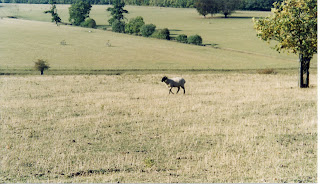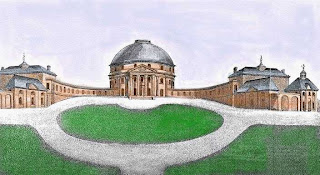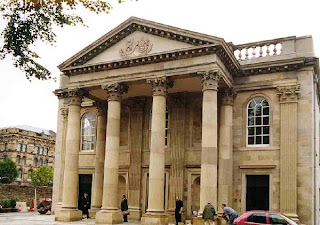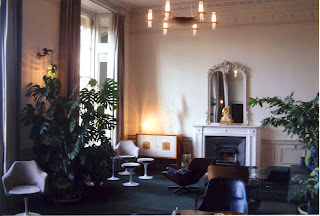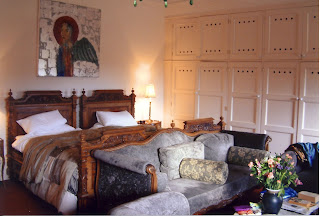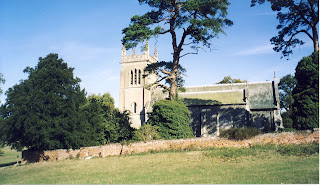Little did Arthur Conan Doyle realize when he wrote his Sherlock Holmes novels that some time in the future, say in the early 21st century, it would be Sherlock’s brother Mycroft who would step into the role of hero. Actually, two heroic roles, as there are two Mycroft Holmes coming to the rescue of the now derelict Undershaw, the Surrey home of Sir Arthur Conan-Doyle – Stephen Fry (above top), who plays Mycroft in the Robert Downey, Jr. big screen version of that story, and Mark Gatiss (above lower) who plays Mycroft in the BBC series Sherlock.
Undershaw, above in its heydey and as it stands today, is where Conan Doyle lived with his wife, Louise, from 1897 to 1907. Conan Doyle commissioned his house specially to take into account the prognosis for his wife Louise, who was suffering from TB and only expected to live a few months. In order to infuse the interiors with lots of healing natural light, Doyle instructed the architect to include oversized windows in his design.
It was whilst living at Undershaw that Conan Doyle became a Deputy Lieutenant of Surrey, and joined the local Chiddingfield Hunt and the golf club and from there that he entered the Boer War as a volunteer army surgeon. It was also at Undershaw that Conan Doyle wrote The Hound of the Baskervilles in 1902. Literary visitors to the house during Conan Doyle’s residency included Bram Stoker, the author of Dracula, who came to interview Conan Doyle, and Virginia Woolf. After 1907, when Conan Doyle sold the property, Undershaw fell into various hands until, from 1924 until 2004, the house was used as a hotel. Since then, the house has stood empty and remains boarded up in a half hearted attempted to save it from further vandalism.
Last year the local authority, Waverley Borough Council, stepped in to prevent the house being turned into 13 different “dwellings.” At the time, it was owned by a company called Fossway. Christopher Atkins, from RDA Architects, speaking on their behalf, says: “It might have been his [Conan Doyle’s] house once, but it has been through a number of different versions since. If it’s left alone, it’ll fall to pieces. The developer’s intention is to provide a number of houses within the existing building and that will then provide the funding to enable it to be restored to its original position.”
Oppostion against the scheme has been great and those working to turn the property into a Sherlock Holmes Museum include local MP and Culture Secretary Jeremy Hunt, Sir Christopher Frayling, Stephen Fry and UPT patron Mark Gatiss, who co-created the BBC series Sherlock and who plays Sherlock’s brother Mycroft in that series. Together, they have formed the Undershaw Preservation Trust.
Stephen Fry has been vocal in his beliefs – the actor, writer, television presenter and film director, who has contributed to three documentaries on Conan Doyle and his character Sherlock Holmes, is a patron of the Conan Doyle library and was once the youngest member of the Sherlock Holmes Society of London.
“There has never been a time when Conan Doyle has gone out of fashion, or interest in him, his ideas and his creations has dropped off the radar,” said Fry. “But there has certainly never been a time when he has been more keenly appreciated and valued than now. . . . As an admirer of Doyle and his achievements, I urge Waverley Borough Council to reconsider what future ages will adjudge [to be] a foolish, short-sighted and wanton act of vandalism. . . . There is real value in Undershaw. If it is thought about, it can attract new generations of tourists to the area, it can be an enormous source of local pride. Please, please, have another think.”
As well, the Victorian Society, which has long been pushing for the Grade II-listed house to be given greater protective status from English Heritage, is also fighting to preserve Undershaw. “We are pushing for Grade I-listing,” says spokeswoman Heloise Brown. “English Heritage originally turned it down on the grounds that Conan Doyle wasn’t on quite the same level as other authors such as Jane Austen or Elizabeth Gaskell. Our argument is that Sherlock Holmes has such immense and universal appeal – there are 400 appreciation societies around the world – that the house really deserves extra protection.”
Visit the Save Undershaw website for further information. You can also visit the Help to Save Undershaw blog here.






















